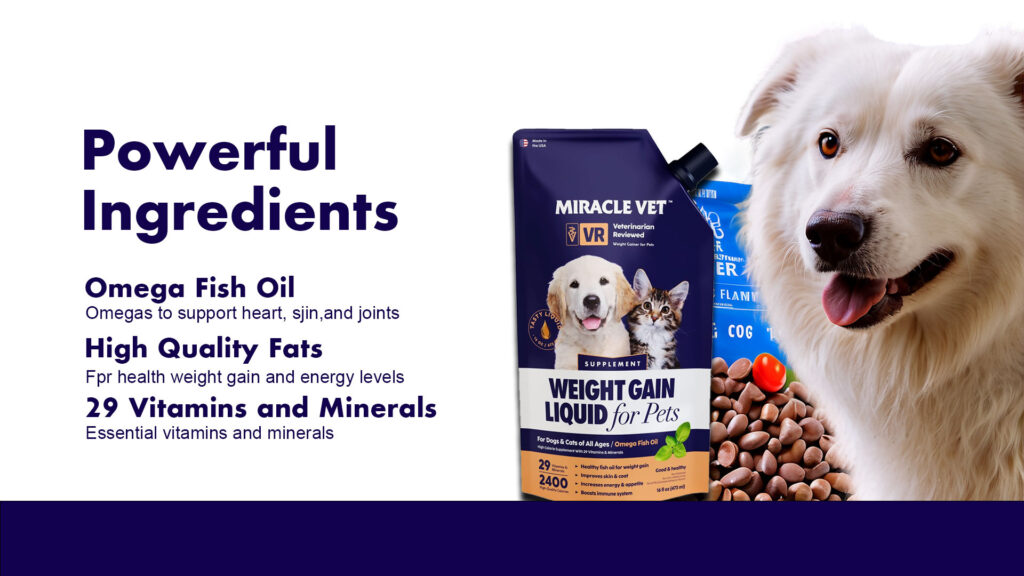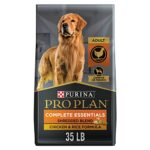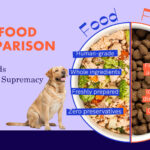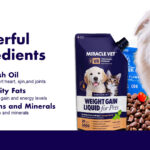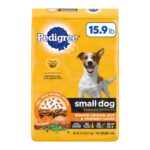Homemade weight gainer for dogs can include high-calorie, nutritious ingredients like peanut butter. Ensure a balanced diet while increasing portion sizes gradually.
Many dog owners might face the challenge of underweight pets. A possible solution lies in homemade weight gainers tailored for dogs. These recipes enrich your dog’s meals with additional calories and essential nutrients, supporting healthy weight gain. Creating a homemade weight gainer allows for control over ingredients, ensuring they’re natural and free from additives.
Typically, protein-rich foods, wholesome grains, and healthy fats serve as the base for these weight gainers. It’s important to consult with a veterinarian to tailor the diet to your dog’s specific health needs and to avoid overfeeding. A well-planned homemade weight gainer can be a safe, effective approach to help your pet reach an optimal weight.
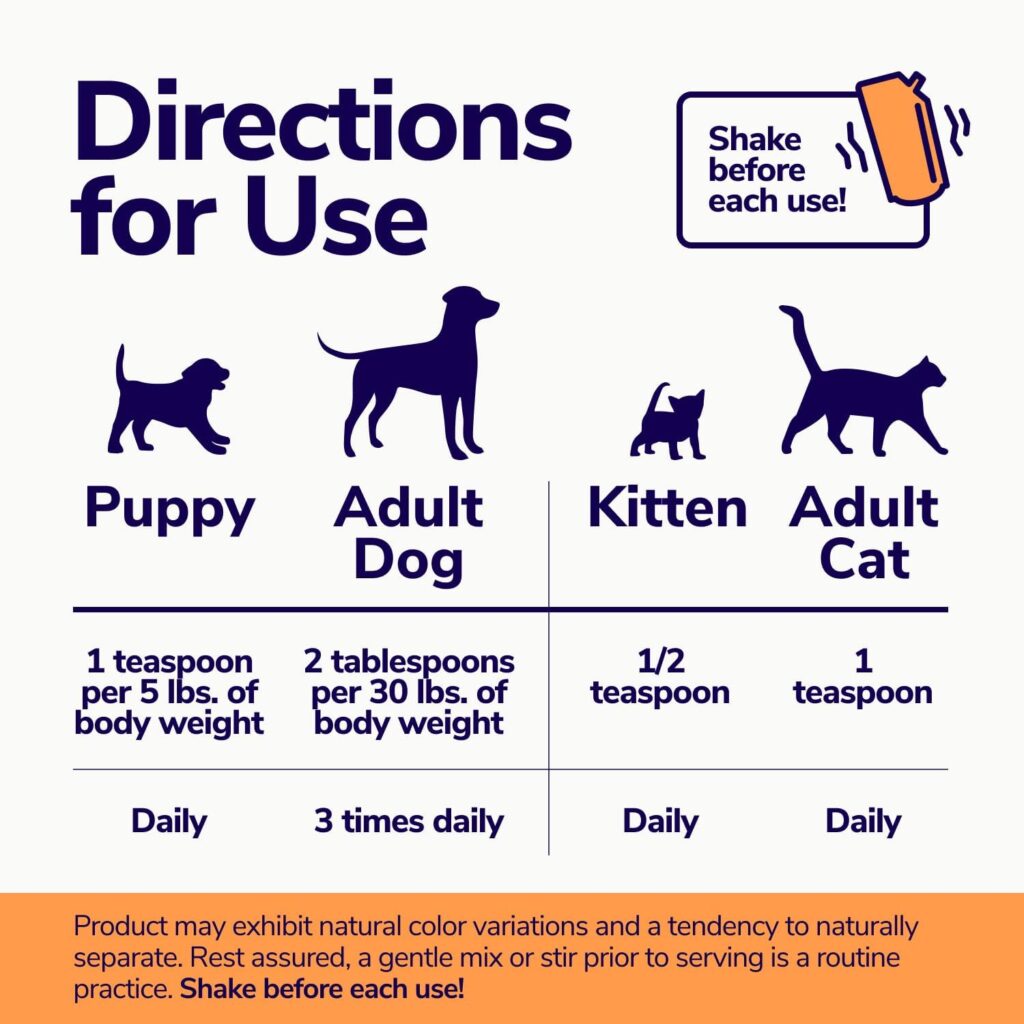
The Scoop On Dog Weight Gain
The journey to optimal health for our canine friends sometimes includes a detour through Weight Gain Lane. For those who have fur-babies that are underweight or struggling to reach an ideal mass, figuring out how to fatten them up safely is crucial. Let’s dip our paws into the bowl of dog weight gain insights!
Why Some Dogs Need Extra Pounds
Just like humans, dogs come in all shapes and sizes. Some dogs have high metabolisms. They burn calories fast. Others might not eat enough because of stress or health issues. Underweight dogs could need more calories. Certain breeds are naturally slimmer but still may need an extra boost to reach a healthy weight. Working dogs and those recovering from sickness often require more calories to maintain their energy needs.
Healthy Vs. Unhealthy Weight Gain
Not all weight is good weight. Dogs need the right kind of weight gain. Fat isn’t always good. Muscles and a balanced diet are important. Dogs should gain weight through proper food and also regular exercise. This ensures they’re building muscle, not just fat.
Healthy dog weight gain involves:
- More protein
- Good fats like omega fatty acids
- Complex carbohydrates for energy
But, it’s not good if:
- They’re eating too much
- They’re only gaining fat
- They’re eating unhealthy human food
Assessing Your Dog’s Dietary Needs
When it comes to our furry friends, ensuring they get the right nutrients is crucial. Some dogs may need a homemade weight gainer to reach their ideal weight. But before diving into a new diet plan, it’s important to understand what they really need. A proper dietary plan caters to their unique requirements and promotes overall health and wellness.
Recognizing Underweight Canines
Determining if your dog is underweight is the first step. Look for visible ribs, hips, and backbone. Their lack of body fat and muscle mass is often visible. Dogs with low weight may also show less energy and a dull coat. Note these signs:
- Visible bones: signifying lower body fat
- Low energy: may hint at poor nutrition
- Dull coat: often a sign of dietary deficiency
Consulting A Vet For A Custom Diet Plan
A vet’s advice is crucial before changing your dog’s diet. Vets consider age, breed, and health to create a perfect plan. They might suggest specific foods or supplements. A professional assessment ensures a safe and effective diet change. Use this checklist for your vet visit:
- Health history: Share any concerning signs
- Current diet: Detail your dog’s current food intake
- Exercise routine: Discuss your dog’s activity level
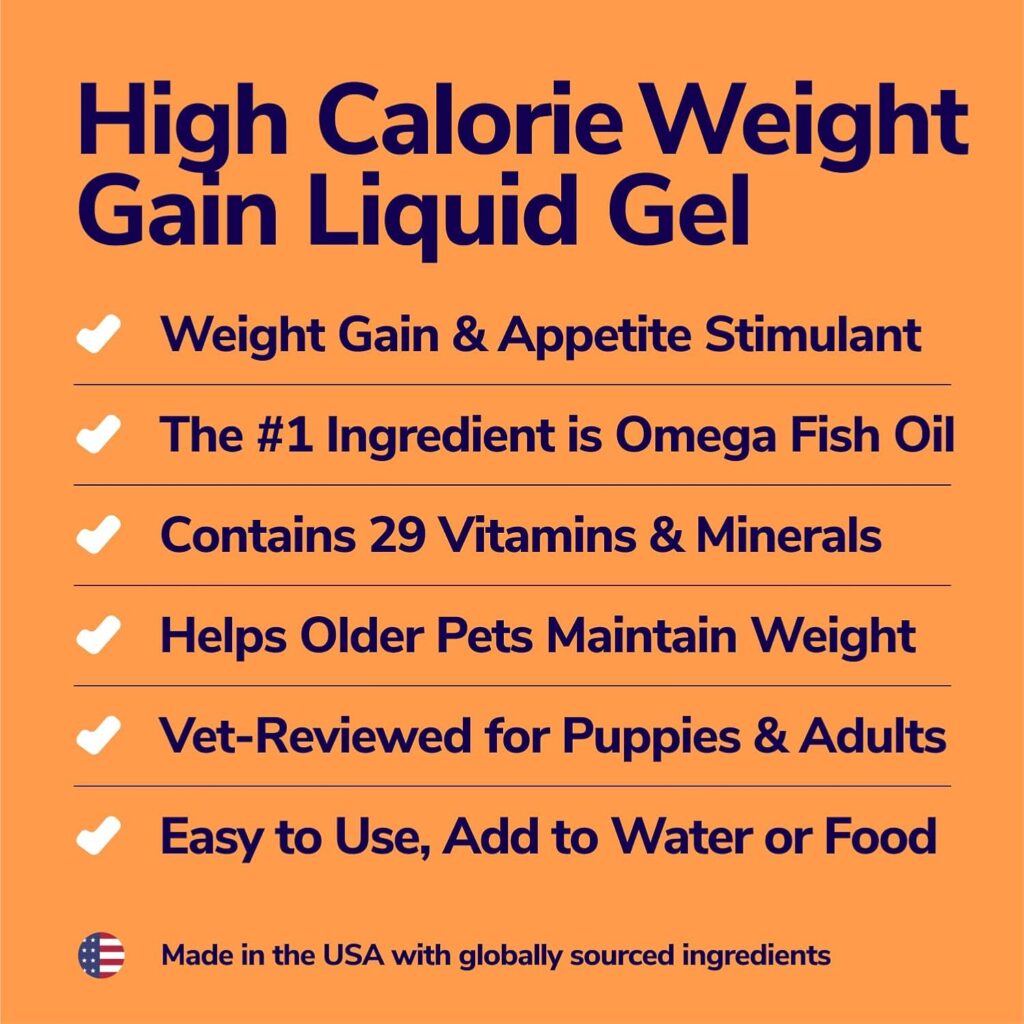
Key Ingredients For Homemade Dog Weight Gainer
Creating a homemade weight gainer for dogs starts with understanding the key ingredients that can help your furry friend gain weight safely and healthily. Whether your dog is underweight due to health issues, has a fast metabolism, or is highly active, adding the right balance of nutrients is critical. Let’s explore the vital components that make for an effective homemade dog weight gainer.
High-calorie Whole Foods
Power-packed with energy, high-calorie whole foods should be the foundation of a weight gain diet. They provide a natural source of calories without unnecessary fillers or unhealthy fats.
- Peanut butter: A calorie-dense treat rich in fat and protein.
- Sweet potato: Packed with vitamins, minerals, and fiber.
- Ground turkey: A lean meat that’s high in protein.
- Cottage cheese: Offers calcium and protein.
- Quinoa: It includes all nine essential amino acids for dogs.
Essential Vitamins And Minerals
Vitamins and minerals support your dog’s immune system and overall health during weight gain. Here are some of the essentials:
| Vitamin/Mineral | Benefit | Food Source |
|---|---|---|
| Vitamin A | Good for vision and immune function. | Carrots, spinach |
| B Vitamins | Energy and metabolism boosters. | Whole grains, beans, yeast |
| Calcium | Essential for strong bones and teeth. | Dairy, bones, green vegetables |
| Iron | Crucial for healthy blood cells. | Red meats, liver, eggs |
Protein Power: Building Muscle In Dogs
‘Protein Power: Building Muscle in Dogs’ throws the spotlight on homemade diets that help dogs bulk up healthily. Animal lovers often ponder how to enhance their furry friends’ physiques. Striking the right balance of protein is crucial for developing strong muscles in dogs, especially when aiming for weight gain. Let’s dive into the high-quality protein sources and understand protein’s pivotal role in canine weight gain.
Best Sources Of Protein For Canines
Identifying top-notch proteins is vital for a weight gain diet. Dogs require complete proteins that offer essential amino acids, the building blocks of muscle.
- Chicken: Lean and packed with essential nutrients.
- Beef: Offers iron and vitamin B12 alongside protein.
- Eggs: A complete protein source, rich in amino acids.
- Fish: Contains omega-3 fatty acids for joint health.
- Dairy: Cottage cheese and yogurt are great options for added protein.
The Role Of Protein In Weight Gain
Protein serves as the foundation for muscle gain. It’s not just about bulking up but also about ensuring healthy weight gain.
- Proteins repair and build muscle tissue.
- They provide the energy needed for play and exercise.
- Proteins increase satiety, aiding in controlled weight gain.
Consistent, quality protein intake will promote lean muscle over fat. Consulting with a vet can provide tailored advice. A vet will consider breed, age, and activity levels before recommending a diet plan.
Balancing Fats In Your Dog’s Diet
A well-balanced diet is vital for a healthy dog, especially when considering weight gain. Fats are a key nutrient in your dog’s diet, providing energy and supporting cell function. Understanding and managing fats within homemade weight gainer concoctions guarantees your dog gains weight the right way.
Healthy Fats For Energy
Dogs need the right kind of fats for energy and health. Healthy fats include:
- Omega-3 fatty acids from fish oil or flaxseed oil.
- Omega-6 fatty acids found in poultry and eggs.
- Small amounts of saturated fats from animal sources.
Include these fats in your dog’s homemade weight gainer for optimal energy and weight gain.
Avoiding Bad Fats
Not all fats are good for your furry friend. Avoid bad fats by:
- Staying away from trans fats found in processed foods.
- Limited use of high-fat treats or human food scraps.
- Reading labels closely to ensure you’re not adding unhealthy fats to homemade recipes.
Keep your dog’s homemade weight gainer healthy and effective by focusing on quality fats only.

Crafting The Recipe: Homemade Weight Gainer
Is your pup looking a little thin? Building a homemade weight gainer can be a wholesome answer. With the right mix of nutrients, your furry friend can reach a healthy weight. Let’s dive into simple recipes and tips to help your dog bulk up in a nutritious way.
Simple High-calorie Dog Food Recipes
Dogs need a balance of protein, fats, and carbs to gain weight safely. Here are some easy-to-make recipes packed with calories and nutrition:
- Peanut Butter and Pumpkin Treat: Combine a cup of pumpkin puree with half a cup of peanut butter. Add oats until the mix is thick. Roll into balls and refrigerate.
- Beefy Rice Delight: Cook ground beef. Mix with cooked rice and a spoon of olive oil. Serve once cool.
- Chicken and Veggie Mash: Boil chicken breasts and vegetables like carrots and peas. Blend into a thick mash for a nutrient-rich meal.
Adjusting Portion Sizes For Weight Gain
Increasing your dog’s portion size may seem straightforward. Yet, it’s essential to do it gradually to avoid digestive issues. Start by adding a little extra to their regular meals. Monitor your dog’s health and behavior closely.
| Meal Size | Frequency | Caloric Increase |
|---|---|---|
| Small | 3-4 times a day | 25% more |
| Medium | 2-3 times a day | 25-50% more |
| Large | 2 times a day | 50% more |
A balanced diet and correct meal portions will ensure your dog gains weight. Look for visual cues and energy levels to adjust as needed. Seek a vet’s advice for a custom plan to suit your dog’s unique needs.
Feeding Schedules For Optimal Weight Gain
Optimal weight gain in dogs is much more than just choosing the right food. It involves a deep understanding of how and when to feed your furry friend. Below, we dive into feeding schedules that can help your dog gain weight in a healthy and controlled manner.
Determining The Right Frequency
Establishing the correct number of meals per day is key to weight gain. This varies based on the dog’s age, size, and health.
- Puppies may need to eat more often—three to four times daily.
- Adult dogs generally require two meals per day.
- Senior dogs or those with certain conditions might need a specialized schedule.
A vet’s advice can ensure the schedule suits your dog’s nutritional needs.
The Impact Of Feeding Times
Feeding times can influence your dog’s metabolism. Consistency aids in better digestion and energy management. Aim for regular intervals.
| Meal | Time |
|---|---|
| Breakfast | 7-8 AM |
| Lunch (if applicable) | 12 PM |
| Dinner | 5-6 PM |
Keep snack times separate, consider a small, nutritious snack between meals if your dog is very active.
Regular check-ins with your vet ensure the feeding schedule promotes healthy weight gain. Tailoring the approach as your dog grows or changes activity levels is essential.
Safe Supplements To Accelerate Weight Gain
Concerned about your dog’s lean frame? Helping your furry friend gain a healthy amount of weight is important for their well-being. Including safe supplements can be a key step in achieving this goal. When chosen wisely and incorporated into your dog’s diet, these supplements can work miracles on your pup’s health, bolstering both weight and wellness.
Choosing The Right Supplements
It’s crucial to select supplements that align with your dog’s dietary needs. Never start a supplement without understanding its purpose and safety. Your vet’s advice is key here. They can recommend the right product that won’t harm your pet.
Look for supplements with high-quality proteins and fats. These are the building blocks for muscle and healthy weight gain. Make sure the ingredients list is short, clear, and easy to understand. Quality over quantity is the mantra for dog supplements.
Natural Supplements For Canine Health
When it comes to bolstering your dog’s diet, natural supplements stand out. Items like pumpkin, peanut butter, and sweet potato are not only tasty but also packed with valuable nutrients.
- Pumpkin: Rich in fiber, this can help your dog feel fuller and enhance digestive health.
- Peanut Butter: Full of healthy fats and proteins, it’s a calorie-dense treat that dogs adore.
- Sweet Potato: High in vitamins and minerals, it’s a nutritious addition to any dog’s diet.
Some dogs may benefit from omega-3 fatty acids found in fish oil supplements. These support not just weight gain but overall health. Probiotics can aid in optimizing digestion, ensuring your dog makes the most of their food.
| Supplement | Benefits |
|---|---|
| Protein Powders | Build muscle and aid recovery |
| Omega-3 Fats | Improve coat health and joint function |
| Probiotics | Enhance gut health and digestion |
Remember, introducing any new supplement should be a gradual process. Observe your dog for any adverse reactions. Finding the right balance is essential to ensure their health and happiness.

Monitoring Your Dog’s Progress
When it comes to bulking up your furry friend with a homemade weight gainer, careful monitoring is crucial. You need to keep an eye on your dog’s progress to ensure they’re getting healthier, not just heavier. This means watching their weight change and body condition closely and being ready to tweak their diet as needed.
Tracking Weight And Body Condition
It’s essential to track both your dog’s weight gain and overall body condition. These two factors give the best picture of your dog’s health.
To start, weigh your dog weekly. Use the same scale each time. Record the numbers to see the changes over time.
- Consistent weigh-ins at the same time of day
- Chart the weight to visualize progress
- Evaluate muscle development and fat deposits
Alongside weighing, assess your dog’s body condition score (BCS). This score rates from one to nine.
| BCS Rating | Condition |
|---|---|
| 1-3 | Too thin |
| 4-5 | Ideal |
| 6-9 | Overweight to obese |
Making Adjustments To The Diet
If your dog’s weight isn’t changing as expected, it’s time to revise the diet. A successful weight gainer plan is adaptable.
For underweight dogs not gaining, increase calorie intake slightly. However, do this gradually. Too many calories too quickly can cause issues.
For dogs gaining too rapidly, reduce the portion size slightly. Aim for steady, healthy weight gain.
Always consult your vet before making any significant changes.
Exercise: A Companion To Diet For Weight Gain
Gaining weight isn’t just about eating more—it’s also about getting the right kind of exercise. When dogs gain muscle, they get heavier and healthier. Let’s explore how exercise works together with a homemade weight gainer diet to help your furry friend bulk up.
Strength Training For Dogs
Strength training is not just for humans. Dogs benefit greatly from exercises that build muscle. Starting with basic moves like fetch and tug-of-war, you can gradually introduce more structured strength-building routines. Consider exercises like:
- Weight pulling – using a weighted vest or pulling small loads.
- Climbing stairs – great for leg muscles.
- Agility course – combines speed with muscle work.
Balancing Exercise And Increased Calories
More food means more energy. With a tailored weight gain diet, you’ll need to ensure your dog burns off the right amount of energy. Here’s how to balance it:
| Exercise Type | Calories Burned | Frequency |
|---|---|---|
| Light Play | Low | Daily |
| Moderate Training | Moderate | 4-5 times/week |
| Intense Strength Training | High | 2-3 times/week |
Keep track of your dog’s daily caloric intake and adjust their exercise routine accordingly. Remember, rest days are essential. Muscles grow during rest. Always consult with a vet about your dog’s exercise regime to avoid overworking them.
Possible Health Risks With Homemade Diets
Crafting a homemade weight gainer for your dog can feel fulfilling. But without proper knowledge, risks may outweigh the benefits. Your pup needs a balanced diet, just like humans do. If made incorrectly, homemade dog foods can lead to health issues, some severe.
Recognizing Nutritional Imbalances
Nutritional imbalances are common in do-it-yourself dog diets. Your furry friend needs a precise mix of proteins, fats, carbohydrates, vitamins, and minerals. Symptoms of a poor diet include:
- Weight loss or gain
- Lethargy
- Changes in fur quality
- Digestive issues
Missing or excess nutrients can cause long-term harm. Bones need calcium for strength. Too much liver can lead to vitamin A toxicity. Balance is crucial!
When To Seek Professional Advice
If your pet shows any unusual signs, contact a vet immediately. Vets provide guidance on homemade diets. They recommend supplements if needed. Their expertise ensures your dog’s diet is complete and balanced.
In conclusion, pay close attention to your dog’s response to a homemade diet. Look out for odd behaviors or health issues. Always consult a professional for the best advice.

The Human-dog Bond Through Cooking
Cooking for your furry friend strengthens the bond you share. It’s more than just meal prep. It’s a token of love, tailored to their health and happiness. Let’s explore how kitchen time can enhance your companionship with your dog.
Sharing Meal Prep Time
Picture a scene where aprons flutter and paws patter. You’re in the kitchen, prepping a weight gainer meal, and your dog is right beside you, full of anticipation. This shared routine isn’t just about feeding; it’s a moment of connection that says, “I care.”
- Gather ingredients together, creating a special ritual.
- Let your dog sniff and explore as you explain what you’re doing.
- Keep it safe and dog-friendly—no chocolate or grapes on the counter!
Understanding Your Dog’s Preferences
Every dog has their own taste. Discovering what makes your dog’s tail wag is part of the joy. Notice the ingredients your dog loves most. Use those to create a personalized weight gainer concoction.
| Ingredient | Health Benefit | Dog’s Reaction |
|---|---|---|
| Peanut Butter | Healthy Fats | Happy Licks |
| Rice | Carbs for Energy | Quick Consumption |
| Pumpkin | Fiber for Digestion | Enthusiastic Sniffs |
Observe and adapt. Your dog’s response guides you to the perfect recipe.
Testimonials: Success Stories Of Weight Gain
Many pet owners dream of a healthy, robust dog. Yet, sometimes, dogs need an extra boost in their diet to reach their ideal weight. Homemade weight gainers can be the secret to a pup’s weight gain journey. We’ve gathered moving testimonials from delighted dog owners who tried homemade weight gain recipes and witnessed amazing success.
Real Experiences With Homemade Gainers
Owners everywhere are sharing their success stories about homemade weight gainers for dogs. These recipes are simple, nutritious, and above all, effective. Read through these real-life experiences to see how others have transformed their dogs’ lives.
- Charlie’s Comeback: A lab with a picky appetite found love for a protein-packed homemade mix. His energy soared, and so did his weight!
- Bella’s Breakthrough: A rescue pup gained the needed pounds within weeks of her new diet.
- Max’s Milestone: After a health scare, Max’s homemade diet helped him reclaim his healthy weight—and his vibrant personality.
Before And After: The Transformations
The proof of a successful weight gain regimen lies in the breathtaking before-and-after stories. Owners are astounded by the visible changes in their dogs, as they share their comparisons:
| Dog Name | Before | After | Time Frame |
|---|---|---|---|
| Rosie | Underweight, low energy | Fit, playful, and full of life | 3 months |
| Zeus | Struggled to gain weight | Healthy weight and thriving | 2 months |
| Luna | Barely ate her meals | Loves her new diet, visibly healthier | 1.5 months |
These stories highlight the power of a tailored diet. They show that with the right nutrients and a little bit of love, any dog can bounce back to their best self.
The Takeaway: Healthy Weight Management For Dogs
Ensuring your dog maintains a healthy weight is crucial for their overall wellbeing. A homemade weight gainer might be a solution for underweight dogs. Remember, the goal is to achieve a balance. Weight management for dogs is all about the right food, exercise, and regular health check-ups. Now, let’s break down some long-term strategies and the importance of vet visits in keeping your furry friend robust and happy.
Long-term Strategies For Maintaining Ideal Weight
- Balance Diet: Craft meals with the right mix of proteins, fats, and carbohydrates.
- Consistent Feeding Schedule: Stick to regular feeding times for predictable digestion.
- Measured Portions: Serve precise amounts to prevent overfeeding.
- Regular Exercise: Plan daily walks and playtime to keep your dog active.
- Healthy Treats: Choose low-calorie snacks to avoid weight gain.
Regular Vet Check-ups For Ongoing Health
Visiting the vet regularly ensures your dog stays healthy. These check-ups can prevent weight-related issues. Vets can provide personalized advice for your dog’s dietary needs. They can adjust feeding plans as your dog ages. Monitoring your dog’s health is key to sustaining an ideal weight.
Frequently Asked Questions Of Homemade Weight Gainer For Dogs
What Can I Give My Dog To Gain Weight?
To help your dog gain weight, increase its calorie intake with high-protein and high-fat foods. Consider nutritious options like puppy food, canned wet food, or adding natural fats like fish oil to their diet. Always consult a veterinarian before altering your dog’s diet.
How Can I Fatten Up My Dogs Homemade Food?
To fatten up your dog’s homemade food, add more calories by including healthy fats like salmon oil or flaxseed oil. Incorporate high-calorie, protein-rich foods such as lean meats, eggs, and cottage cheese. Always consult your vet before changing your dog’s diet.
Does Rice Help Dogs Gain Weight?
Yes, rice can help dogs gain weight when incorporated into their diet in appropriate portions as it is a high-carbohydrate food.
How Can I Add Fat To My Dog’s Diet?
To add fat to your dog’s diet, include a spoonful of suitable oil, like flaxseed or coconut oil. Alternatively, mix in some wet food with healthy fats or offer small portions of safe fatty treats, such as plain cooked salmon. Always consult your vet before changing your dog’s diet.
What Ingredients Are In Homemade Dog Weight Gainer?
Homemade dog weight gainers typically include high-calorie, nutritious ingredients such as peanut butter, pumpkin, sweet potato, lean meats, and rice to safely boost your pet’s caloric intake.
Conclusion
Boosting your dog’s weight can be simple and nutritious with homemade gainers. Blend wholesome ingredients like peanut butter, oats, and lean meats for a cost-effective, healthful supplement. Remember, consult your vet for tailored advice. Empower your pup’s growth journey with love and a balanced diet, starting in your own kitchen.

